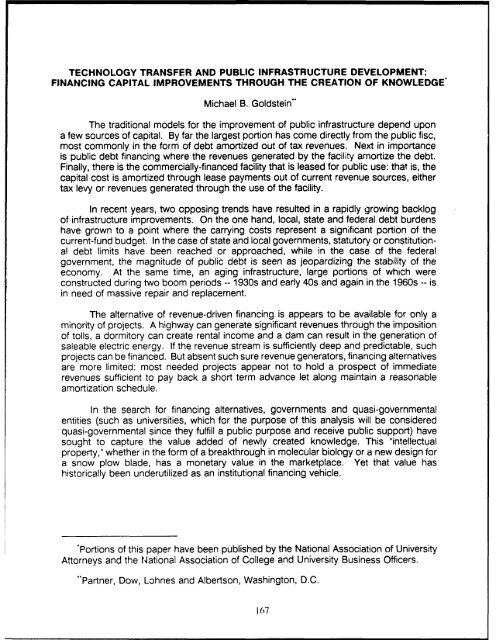Challenges and Opportunities for Innovation in the Public Works ...
Challenges and Opportunities for Innovation in the Public Works ...
Challenges and Opportunities for Innovation in the Public Works ...
Create successful ePaper yourself
Turn your PDF publications into a flip-book with our unique Google optimized e-Paper software.
TECHNOLOGY TRANSFER AND PUBLIC INFRASTRUCTURE DEVELOPMENT:<br />
FINANCING CAPITAL IMPROVEMENTS THROUGH THE CREATION OF KNOWLEDGE<br />
Michael B. Goldste<strong>in</strong>**<br />
The traditional models <strong>for</strong> <strong>the</strong> improvement of public <strong>in</strong>frastructure depend upon<br />
a few sources of capital. By far <strong>the</strong> largest portion has come directly from <strong>the</strong> public fisc,<br />
most commonly <strong>in</strong> <strong>the</strong> <strong>for</strong>m of debt amortized out of tax revenues. Next <strong>in</strong> importance<br />
is public debt f<strong>in</strong>anc<strong>in</strong>g where <strong>the</strong> revenues generated by <strong>the</strong> facility amortize <strong>the</strong> debt.<br />
F<strong>in</strong>ally, <strong>the</strong>re is <strong>the</strong> commercially-f<strong>in</strong>anced facility that is leased <strong>for</strong> public use: that is, <strong>the</strong><br />
capital cost is amortized through lease payments out of current revenue sources, ei<strong>the</strong>r<br />
tax levy or revenues generated through <strong>the</strong> use of <strong>the</strong> facility.<br />
In recent years, two oppos<strong>in</strong>g trends have resulted <strong>in</strong> a rapidly grow<strong>in</strong>g backlog<br />
of <strong>in</strong>frastructure improvements. On <strong>the</strong> one h<strong>and</strong>, local, state <strong>and</strong> federal debt burdens<br />
have grown to a po<strong>in</strong>t where <strong>the</strong> carry<strong>in</strong>g costs represent a significant portion of <strong>the</strong><br />
current-fund budget. In <strong>the</strong> case of state <strong>and</strong> local governments, statutory or constitutional<br />
debt limits have been reached or approached, while <strong>in</strong> <strong>the</strong> case of <strong>the</strong> federal<br />
government, <strong>the</strong> magnitude of public debt is seen as jeopardiz<strong>in</strong>g <strong>the</strong> stability of <strong>the</strong><br />
economy. At <strong>the</strong> same time, an ag<strong>in</strong>g <strong>in</strong>frastructure, large portions of which were<br />
constructed dur<strong>in</strong>g two boom periods -- 1930s <strong>and</strong> early 40s <strong>and</strong> aga<strong>in</strong> <strong>in</strong> <strong>the</strong> 1960s -- is<br />
<strong>in</strong> need of massive repair <strong>and</strong> replacement.<br />
The alternative of revenue-driven f<strong>in</strong>anc<strong>in</strong>g is appears to be available <strong>for</strong> only a<br />
m<strong>in</strong>ority of projects. A highway can generate significant revenues through <strong>the</strong> imposition<br />
of tolls, a dormitory can create rental <strong>in</strong>come <strong>and</strong> a dam can result <strong>in</strong> <strong>the</strong> generation of<br />
saleable electric energy. If <strong>the</strong> revenue stream is sufficiently deep <strong>and</strong> predictable, such<br />
projects can be f<strong>in</strong>anced. But absent such sure revenue generators, f<strong>in</strong>anc<strong>in</strong>g alternatives<br />
are more limited: most needed projects appear not to hold a prospect of immediate<br />
revenues sufficient to pay back a short term advance let along ma<strong>in</strong>ta<strong>in</strong> a reasonable<br />
amortization schedule.<br />
In <strong>the</strong> search <strong>for</strong> f<strong>in</strong>anc<strong>in</strong>g alternatives, governments <strong>and</strong> quasi-governmental<br />
entities (such as universities, which <strong>for</strong> <strong>the</strong> purpose of this analysis will be considered<br />
quasi-governmental s<strong>in</strong>ce <strong>the</strong>y fulfill a public purpose <strong>and</strong> receive public support) have<br />
sought to capture <strong>the</strong> value added of newly created knowledge. This "<strong>in</strong>tellectual<br />
property," whe<strong>the</strong>r <strong>in</strong> <strong>the</strong> <strong>for</strong>m of a breakthrough <strong>in</strong> molecular biology or a new design <strong>for</strong><br />
a snow plow blade, has a monetary value <strong>in</strong> <strong>the</strong> marketplace. Yet that value has<br />
historically been underutilized as an <strong>in</strong>stitutional f<strong>in</strong>anc<strong>in</strong>g vehicle.<br />
"Portions of this paper have been published by <strong>the</strong> National Association of University<br />
Attorneys <strong>and</strong> <strong>the</strong> National Association of College <strong>and</strong> University Bus<strong>in</strong>ess Officers.<br />
"'Partner, Dow, Lohnes <strong>and</strong> Albertson, Wash<strong>in</strong>gton, D.C.<br />
167







